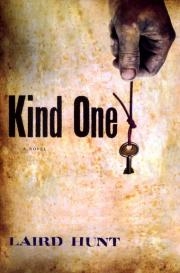
Kind One
by Laird Hunt
Coffee House Press
Laird Hunt’s bleak work Kind One (winner of the 2013 Anisfield-Wolf Book Award, and 2013 PEN/Faulkner Award Finalist) is either a limited historical novel or an extended revenge narrative. As the first, it describes slavery at one specific farm in a border state, yet without providing overall context for the reader to situate the narrative. As the latter, it’s about weak people who gain power and use it to punish their tormenters. Kind One doesn’t deliver completely on either of these fronts. Were it a historical novel, I would have expected the story to connect to historical events, to give it authenticity and a sense of continuity. Were it a revenge narrative, I would have wanted to feel more satisfaction about the characters’ resolution. In spite of these drawbacks and a wish that Hunt had been more ambitious with his storytelling, however, I had an intense emotional response to this novel; it would be hard not to have that response when reading about a battered wife who in turn abuses her slaves and then must face the consequences when they revolt.
Ginny Lancaster, the main narrator of the novel, marries Linus Lancaster at fourteen during the 1850s. Her husband is her mother’s second cousin and a brutal slaveholder who beats her and his slaves. When she doesn’t get pregnant, he takes to “visiting” two of the slaves, Zinnia and Cleome, who are younger than she. In fits of jealousy, Ginny starts beating them, hitting them over the head with objects when they show disrespect and slapping them for no immediate reason. As the story progresses, control and power shift from one character to the other, forcing each one to face his or her own actions with sometimes fatal results.
The novel is told from five distinct points of view, all in first person. The prologue, told by an unnamed character, could nearly function as a stand-alone short story. Other portions are told from the points of view of Ginny; Zinnia; Prosper, Zinnia’s nephew; and Lucious Wilson, the man who takes Ginny in during her later years. The text reads as though the narrators are each adding their portion to a collective mass before passing it on to the next in line. All of the sections show that every action has a reaction—and that sometimes the reactions don’t fit the actions at all.
Ginny claims the largest section, both in pages and in influencing the story’s outcomes. Her narrative switches between her time on the farm of Linus and the years after that trauma, which she lives out on Lucious Wilson’s farm. Ginny’s voice is strong and, as we descend into her mind, becomes increasingly unreliable. After the two slaves take over the farm, Ginny is tortured and her mind bends under the pressure, experiencing dream images and hallucinations. Alcofibras, one of the slaves whom Linus had whipped to death, appears to her while she’s chained to the ground in a shed: “Alcofibras flung back that shawl and showed out his whip-cut shoulders. . . . As I looked an eye the size of a saucer opened up in the middle of his shoulders then closed . . . and mouths grew up over his arms and legs and each one of them opened and all of them wailed at once, then went closed and quiet.” Because of such surreal images, the reader cannot assume her voice is wholly trustworthy.
Though the hallucinations begin about halfway through the book, the language beforehand leaves much open for question as well. I often found it frustrating not to be able to nail down facts in the narrative. Are Zinnia and Cleome Linus’s daughters or only his slaves? Is everyone, including slaveholders Linus and Ginny, black, or are some of them white? At first these gaps in setting and exposition seem like oversights on Hunt’s part. As the plot proceeds, however, Hunt makes it clear that he has withheld the information deliberately. My head was spinning with elation when I encountered the grand reveals he presents in the last third of the book, yet at the same time they felt a little dirty and cheap, a play for my admiration.
Throughout the book, though, my attention was enchanted by Hunt’s image-rich language. This was especially so as I read Ginny’s section. She tells the reader about her new home: “I liked to stand at a window and bite off pieces of that breeze. That was a breeze to chew on and think about and swallow. Never mind that winter hadn’t come yet to freeze it all until your teeth would snap straight off in your mouth if you smiled.” When her father comes to visit, obviously disapproving of Linus, Ginny observes, “[H]e looked at Linus Lancaster asleep there in his drink and laughed. He laughed so long and hard that after a while it seemed like that laugh had left away from him and had hitched up its skirts and was dancing with hard boots on the table in front of us.” Later, after Ginny leaves Linus’s farm, she thinks, “If I could have gathered myself up and turned into smoke then I would have. I would have joined my smoke to his and drifted on out the window.” These sensory portrayals of experiences give the narrative a dreamlike quality enhanced by the descriptions of sweeping fields. However, Hunt gives the entire account an uncomfortable edge to offset the extensive use of metaphor and occasional surrealism: bouts of descriptive gore and abuse, inflicted by humans and by animals. Most of the sex is violent, yet the actual act is never described beyond the teenage girls’ attempts to dissociate from the situation.
All of the characters are emotionally affected by their actions and believe that they will suffer eternal punishment. Religion is never directly discussed other than a mention of church attendance, yet there are significant references to life and death, sin and punishment, mercy and unattainable absolution. Linus burns Ginny’s secular books, telling her she should read the Bible as his first wife did, but she can never find one in his house. The characters all refer to Linus Lancaster’s property as “Paradise,” as he calls it, until Ginny finally leaves and calls it by its inverse. The effect is clear: religion is an unquestioned, incontrovertible way of life in this book, yet not a motivation to affect anyone’s actions.
More than anything, though, this story is about land and its unchanging nature. As Ginny’s father tells her, by her report: “The land is the land and the land washes itself clean.” People may do evil things, but the land on which they commit these crimes will remain untouched—through all the different owners, generations, and wars.
Hunt eschews a tone or style that would allow the reader to contextualize his narratives of slavery in America. Paradise is “ninety miles from nowhere.” Most of the contemplations are internal, focusing on how the characters feel rather than what they think about their roles in life—for example, Ginny blames herself for convincing Linus Lancaster to marry her. Kind One offers a telling alternative to what we are accustomed as a society that once practiced slavery and subsequently banned it—a telling that zeroes in, with painstaking focus, on the experiences and development of a few characters whose stories represent much of the suffering endured by slaves in the 1850s.
At times the novel is disjointed and uneven. Even though each character receives his or her just deserts, the revenge is deeply unsatisfying. In spite of this, though, Hunt’s adeptness with language and his ability to develop distinctive characters make this novel a worthwhile read. Like his characters, he most certainly knows how to spin a yarn.


